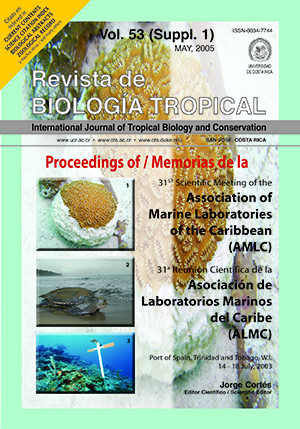Resumen
Para mantener la competitividad regional y la viabilidad económica del Puerto de Bustamante - Kingston Harbour, Jamaica, se requería mejorar la entrada de buques de contenedores “Post Panamax” (nombre dado a los buques que son demasiado grandes para pasar por el canal de Panamá). Se propuso remover la parte norte del cayo coralino Rackham que obstruía parcialmente el lado oeste del canal del este. Este arrecife, estéticamente valioso, era usado por pescadores y forma parte del Área Protegida Palisadoes – Port Royal. Se propuso transplantar algunos organismos bentónicos para mitigar las pérdidas de elementos arrecifales. Entre diciembre 2001 y febrero 2002, se reubicó unos 60 000 organismos de corales constructores de arrecifes masivos y ramificados, gorgonaceos, erizos (Diadema y Tripneustes spp.) y meristemos de Thalassia. Durante el dragado las cantidades de sedimentos en suspensión fueron de 0.003 g/cm2/día en el sitio testigo y 0.008 g/cm2/día en el sitio de dragado. La cobertura de coral aumentó en el sitio de reubicación de 15% a 20% mientras que el sustrato desnudo disminuyó de 27% a 21%. En este trabajo se documentan los requerimientos para la mitigación; algunos factores que controlan la ecología del arrecife del Cayo Rackham; la metodología del proceso de reubicación; y el nivel de supervivencia de corales reubicados. Es común que se dé más importancia a consideraciones políticas y económicas de algunas propuestas de desarrollo que a las consideraciones ecológicas. El transplante de especies marinas bentónicas importantes, aunque consume mucho tiempo, es técnicamente desafiante y costoso, es una forma en que los “desarrollistas” y los “ecologistas” pueden alcanzar objetivos dispares. Este proyecto costó EEUU$1.7 millones. Los organismos trasladados no eran únicos ni endémicos y siguen siendo vulnerables a impactos naturales y antropogénicos. Sin embargo, este proyecto aumentó la percepción e interés en la importancia ecológica y económica de los arrecifes coralinos. Se anticipa que futuros proyectos de desarrollo costeros y de tierra adentro se van a beneficiar de las lecciones aprendidas durante esta intento de mitigación.Citas
Benayahu, Y. & Y. Loya. 1981. Competition for space among coral reef sessile organisms of Eilat (Red Sea). Bull. Mar. Sci. 31: 514-522.
Bouchon, C., J. Jaubert & Y. Bouchon-Navaro. 1981. Evolution of a semi artificial reef built by transplanting coral heads. Tethys 10: 173-176.
Chornesky, E.C. 1989. Repeated reversals during spatial competition between corals. Ecology 70: 843-855.
Chevannes-Creary, M. 2001. Caribbean Planning for Adaptation to Global Climate Change. Component 5: Coral Reef Monitoring for Climate Change Impacts. Benthic Features Manual – Jamaica.
Harriott, V.J. & D.A. Fisk. 1988. Coral transplantation as a reef management option. Proc. 6th Int. Coral Reef Symp. Australia 2: 375-379.
Jaap, W.C. 2000. Coral reef restoration. Ecol. Engin. 15: 345-364.
Lang, J.C. & E.C. Chornesky. 1990. Competition between scleractinian reef corals: a review of mechanisms and effects, p. 209-252. In Z. Dubinsky (ed.). Ecosystems of the World, Vol. 25 Coral Reefs. Elsevier, Amsterdam, Netherlands.
Rogers, C.S. 1990. Responses of coral reef and reef organisms to sedimentation. Mar. Ecol. Prog. Ser. 62: 185-202.
Schumacher, H. 1988. Development of coral communities on artificial reef types over 20 years. Proc. 6th Int. Coral Reef Symp. Townsville 2: 379-384.
##plugins.facebook.comentarios##

Esta obra está bajo una licencia internacional Creative Commons Atribución 4.0.
Derechos de autor 2005 Revista de Biología Tropical






